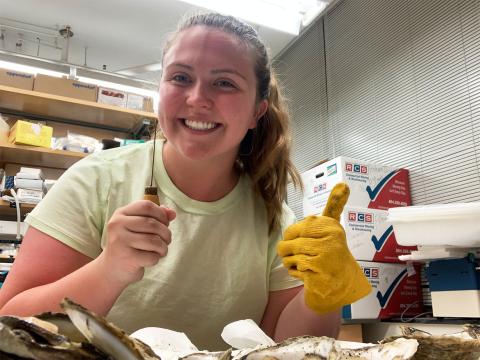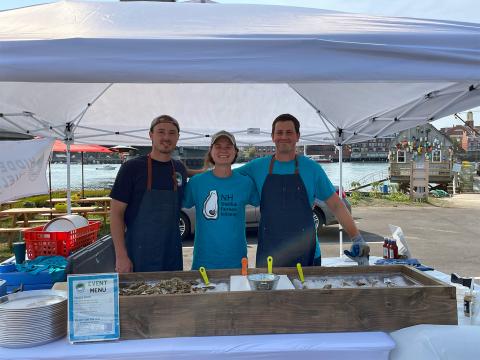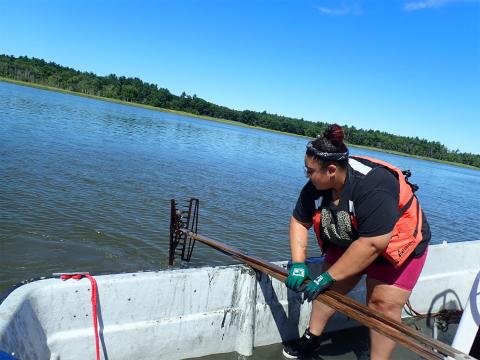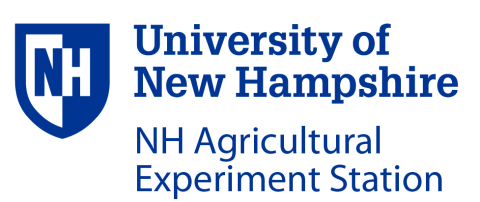About the Research
Eastern oysters, or Crassostrea virginica, are cultivated widely along the North American Atlantic coast for commercial and restoration purposes. Like their wild brethren, farmed oysters are experiencing a multi-pronged assault that is affecting production and the ecosystem services they provide. Oysters in New Hampshire's Great Bay Estuary (GBE), as in many other locations, are under duress from a number of factors, including disease (MSX [Haplosporidium nelsoni] and Dermo [Perkinsus marinus]), overharvesting, habitat disturbance (siltation), and invasive organisms that either compete for space (tunicates, for example) or predate on them, like with green crabs and blue crabs.
A primary focus of the research of the Ecological Genetics Laboratory (EGL) at UNH is to investigate the effects of these factors and find solutions that facilitate oyster aquaculture and restoration in GBE. Since 2018, scientists with the EGL have:
About the Researcher

Bonnie Brown
Professor of Biological Sciences
Bonnie.Brown@unh.edu; 603-862-4200
» The UNH Ecological Genetics Laboratory
Check out COLSA student research spotlights:
- Assessed the recruitment potential and interactions between cultivated and wild oysters
- Developed new methods to detect oyster disease in GBE waters and oysters, and
- Worked with colleagues in UNH’s Department of Earth Sciences and the Ocean Engineering to craft a model designed to understand larval transport throughout the GBE and predict where larval settlement might be greatest.
- Discovered the first mating pair of blue crabs in GBE.
Why the Research is Important
Like healthy wild oyster reefs, it is generally understood that oyster farms provide important ecosystem services such as habitat and nutrient processing. However, the region's wild oyster population has been reduced to less than 10 percent of its historic size. One of the most promising services yet to be investigated is the potential for farmed oysters to produce larvae that can supplement declining recruitment from wild oysters. Working with funding and management agencies, Great Bay oyster aquaculturists have contributed hundreds of thousands of large adult oysters to supplement wild reef populations. The work of the EGL involves quantifying when and where oyster larvae are in the waters and then locating new recruits (called oyster spat) both at the restoration sites and around the Bay and determining whether their parents were wild or aqua-cultured oysters.
In GBE, both Dermo and MSX cause oyster mortality. The protozoans that produce these two oyster diseases are spread widely within the wild oyster population, where they have a history of alternate infection. Interestingly, however, the role of disease in New Hampshire’s cultivated oysters has not been studied. The EGL team has developed and optimized a molecular technique to simultaneously assess Dermo and MSX occurrences in water, larvae and oysters. Until now, diagnosis of these diseases in NH oysters has been done only using histological techniques.

Key Findings
Work in GBE has:
- Quantified oyster larval abundance in the Bay
- Assessed when and where the larval oysters set (to hopefully become part of the "wild" oyster population)
- Created molecular testing to diagnose oyster diseases in cultivated and wild stocks and detect the disease causing protozoans in the water column, and
- Optimized genetic tags that can be used to detect whether individual larva were the progeny of either cultivated or wild oysters.
EGL scientists have also noted that due to climate change, oysters spawn much earlier in GBE than they did in previous decades (now in May and June as opposed to June and July). They've also documented a decline in larval settlement in most areas of the Bay, which lends greater importance to documenting the ways in which cultivated oysters can enhance recruitment to the Bay’s wild oyster population. Additionally, disease testing has confirmed that the wild oyster population is being stressed more by Dermo than by MSX, likely because Dermo thrives in the warming waters.

COLSA graduate student Kelsey Meyer (center) with two oyster farmers at an event with Hidden Coast Shellfish.
Big Picture
GBE is a complex and evolving ecosystem that is responding simultaneously to effects of terrestrial development and climate change. Another component of this large project involves "metagenomics," i.e. the investigation of genetic material obtained directly from environmental samples. Using DNA isolated from particles distributed in the GBE water column, the EGL team has detected and monitored disease-causing organisms in the environment.
Metagenomics also is being used by the team as a means for diet analysis of invasive species like blue crabs to determine which resident organisms are affected by the introduction of new predators. As climate continues to change and water gets warmer, it will be critical to know how new predators in an ecosystem are directly impacting native organisms. If readers document blue crabs in Great Bay, especially those mating, they can contact UNH at Blue.Crab@unh.edu to submit photos, location, and dates.

COLSA graduate student Taja Sims-Harper accompanies The Nature Conservancy’s Brianna Group and shows high school students how to tong for oyster samples.
Funding
- NH Agricultural Experiment Station Hatch 1023564 (NH 00697)
- Hubbard Fund Graduate Research Assistantship (TS-H)
- New Hampshire Sea Grant Projects A/EXT-4, pursuant to National Oceanic and Atmospheric Administration Award No. NA18OAR4170090
- New Hampshire Sea Grant Graduate Fellows (2)
Related Published Works
- Cheng MLH, TC Lippmann, JA Dijkstra, G Bradt, S Cook, J-G Choi, and BL Brown. 2021. A baseline for microplastic particle occurrence and distribution in Great Bay Estuary. Marine Pollution Bulletin. 170: 1126653.
- Stasse A, ML Cheng, K Meyer, N Bumbera, K Van Volkom, AM Laferriere, JA Dijkstra, B Brown. 2022. Temporal dynamics of eastern oyster larval abundance in Great Bay Estuary, New Hampshire. Journal of Shellfish Research 40: 471-478.
- Stasse A. 2021. Larval assessment and infection etiology of cultivated and wild eastern oysters, Crassostrea virginica, of Great Bay Estuary, NH. MS thesis, University of New Hampshire.
- Stasse A, K Meyer, E Williams, G Bradt, B Brown. (in review) First documentation of mating nlue crabs, Callinectes sapidus, in Great Bay Estuary, New Hampshire. Submitted to Northeastern Naturalist 9 September 2022.
- Stasse A, B-Y Lee, B Brown. (in review) Haplosporidium Nelson and Perkinsus marines occurrence in waters of Great Bay Estuary, NH. submitted to Diseases of Aquatic Organisms 26 Sept 2022.
Additional Resources
For more information:

This project recieved funding support from the New Hampshire Agricultural Experiment Station at UNH!